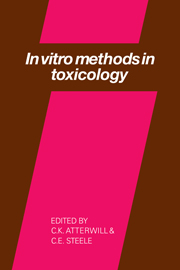Book contents
- Frontmatter
- Contents
- List of contributors
- Preface
- Introduction
- TARGET ORGAN TOXICITY
- In vitro methods in renal toxicology
- Ototoxicity
- Cultured cell models for studying problems in cardiac toxicology
- Use of the isolated rat heart for the detection of cardiotoxic agents
- Brain reaggregate cultures in neurotoxicological investigations
- Application of thryoid cell culture to the study of thyrotoxicity
- In vitro methods to investigate toxic lung disease
- Metabolism and toxicity of drugs in mammalian hepatocyte culture
- In vitro evaluation of haemic systems in toxicology
- GENERAL AND TOPICAL TOXICITY
- REPRODUCTIVE TOXICITY
- CONCLUSION
- Index
Brain reaggregate cultures in neurotoxicological investigations
Published online by Cambridge University Press: 06 August 2010
- Frontmatter
- Contents
- List of contributors
- Preface
- Introduction
- TARGET ORGAN TOXICITY
- In vitro methods in renal toxicology
- Ototoxicity
- Cultured cell models for studying problems in cardiac toxicology
- Use of the isolated rat heart for the detection of cardiotoxic agents
- Brain reaggregate cultures in neurotoxicological investigations
- Application of thryoid cell culture to the study of thyrotoxicity
- In vitro methods to investigate toxic lung disease
- Metabolism and toxicity of drugs in mammalian hepatocyte culture
- In vitro evaluation of haemic systems in toxicology
- GENERAL AND TOPICAL TOXICITY
- REPRODUCTIVE TOXICITY
- CONCLUSION
- Index
Summary
General Introduction
Rotation-mediated aggregating cultures constructed from single cell suspensions of foetal brain have so far proved extremely useful and informative in multi-disciplinary neurobiological and neuropharmacological studies. However they have not yet been as extensively used for neurotoxicological investigations as have monolayer and explant cultures. Brain reaggregates appear to restrict cellular division whilst enhancing biochemical and morphological differentiation (see Seeds et al, 1980) and more closely reflect the in vivo developmental process than primary monolayer cultures. In fact, in several instances they have been found to express systems found in vivo and not in surface culture such as some of the myelin-related enzymes.
In common with other tissue culture models there are several advantages over in vivo studies (see also section D), added advantages being firstly the high tissue yield for neurochemical analysis, and secondly their long survival in chemically-defined, serum-free media (Honegger & Lenoir, 1980; Atterwill et al, 1985) enabling detailed studies of hormone action to be carried out. Of interest is a report that the longevity of cells in brain aggregate cultures can be further enhancaed by the addition of vitamin E.
The cells within these organotypic cultures change from a population of completely undifferentiated neuroepithelial cells to an integrated population of neurones, astroglia and oligodendroglia. The brain cells are generally mechanically dissociated (this is preferable to trypsinization, giving more viable cells) from 15–16 day rat foetuses and the cultures remain viable for around one to two months.
- Type
- Chapter
- Information
- In Vitro Methods in Toxicology , pp. 133 - 164Publisher: Cambridge University PressPrint publication year: 1987
- 3
- Cited by



